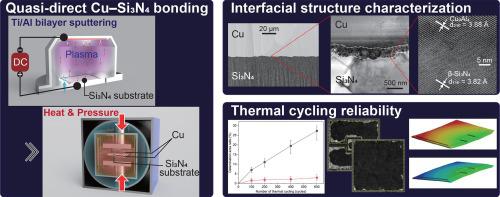当前位置:
X-MOL 学术
›
Mater. Des.
›
论文详情
Our official English website, www.x-mol.net, welcomes your
feedback! (Note: you will need to create a separate account there.)
Quasi-direct Cu–Si3N4 bonding using multi-layered active metal deposition for power-module substrate
Materials & Design ( IF 7.6 ) Pub Date : 2024-01-06 , DOI: 10.1016/j.matdes.2024.112637
Hiroaki Tatsumi , Seongjae Moon , Makoto Takahashi , Takahiro Kozawa , Eiki Tsushima , Hiroshi Nishikawa
Materials & Design ( IF 7.6 ) Pub Date : 2024-01-06 , DOI: 10.1016/j.matdes.2024.112637
Hiroaki Tatsumi , Seongjae Moon , Makoto Takahashi , Takahiro Kozawa , Eiki Tsushima , Hiroshi Nishikawa

|
The advancement of power modules demands more reliable insulating circuit substrates. Traditional substrates, comprising Cu and Si3 N4 , are produced using active metal brazing (AMB). However, AMB substrates have reliability concerns owing to electrochemical migration and void formation from brazing filler metals. This study introduces a quasi-direct Cu–Si3 N4 bonding technique using a Ti/Al bilayer active metal deposition at the bonding interface. A sputtered Ti/Al bilayer was formed on the Si3 N4 surface, then heated and pressurized the sputtered Si3 N4 substrate with Cu sheets in vacuum to bond each other without voids or delamination. The Ti/Al layers reacted with Si3 N4 and Cu, forming a 300 nm intermediate layer. TEM observations show this layer contains segregated Ti–N and Cu–Al phases, with a good lattice match to Si3 N4 and Cu–Al. Temperature-cycling tests on the Cu/Si3 N4 /Cu substrate revealed delamination caused by increased tensile stress at the periphery of the bonding area due to asymmetrical Cu patterns. This novel quasi-direct Cu–Si3 N4 bonding technique addresses issues of electrochemical migration and void formation seen in AMB substrates, offering a reliable bonding interface for power electronic substrates.
中文翻译:

使用多层活性金属沉积的准直接 Cu-Si3N4 键合用于功率模块衬底
功率模块的发展需要更可靠的绝缘电路基板。由铜和 Si3N4 组成的传统基板是使用活性金属钎焊 (AMB) 生产的。然而,由于钎料的电化学迁移和空洞形成,AMB 基板存在可靠性问题。本研究介绍了一种准直接 Cu-Si3N4 键合技术,在键合界面处使用 Ti/Al 双层活性金属沉积。在 Si3N4 表面形成溅射的 Ti/Al 双层,然后在真空中将溅射的 Si3N4 衬底与 Cu 片一起加热加压,以相互粘合而不会产生空隙或分层。Ti/Al 层与 Si3N4 和 Cu 反应,形成 300 nm 中间层。TEM 观察表明,该层包含分离的 Ti-N 和 Cu-Al 相,与 Si3N4 和 Cu-Al 具有良好的晶格匹配。Cu/Si3N4/Cu 衬底的温度循环测试显示,由于不对称的 Cu 图案,键合区域外围的拉伸应力增加导致分层。这种新颖的准直接 Cu-Si3N4 键合技术解决了 AMB 衬底中出现的电化学迁移和空隙形成问题,为电力电子衬底提供了可靠的键合界面。
更新日期:2024-01-06
中文翻译:

使用多层活性金属沉积的准直接 Cu-Si3N4 键合用于功率模块衬底
功率模块的发展需要更可靠的绝缘电路基板。由铜和 Si3N4 组成的传统基板是使用活性金属钎焊 (AMB) 生产的。然而,由于钎料的电化学迁移和空洞形成,AMB 基板存在可靠性问题。本研究介绍了一种准直接 Cu-Si3N4 键合技术,在键合界面处使用 Ti/Al 双层活性金属沉积。在 Si3N4 表面形成溅射的 Ti/Al 双层,然后在真空中将溅射的 Si3N4 衬底与 Cu 片一起加热加压,以相互粘合而不会产生空隙或分层。Ti/Al 层与 Si3N4 和 Cu 反应,形成 300 nm 中间层。TEM 观察表明,该层包含分离的 Ti-N 和 Cu-Al 相,与 Si3N4 和 Cu-Al 具有良好的晶格匹配。Cu/Si3N4/Cu 衬底的温度循环测试显示,由于不对称的 Cu 图案,键合区域外围的拉伸应力增加导致分层。这种新颖的准直接 Cu-Si3N4 键合技术解决了 AMB 衬底中出现的电化学迁移和空隙形成问题,为电力电子衬底提供了可靠的键合界面。

































 京公网安备 11010802027423号
京公网安备 11010802027423号